Article and photos by Joe Mish
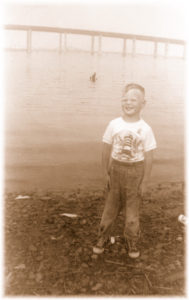
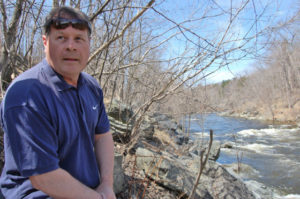
If shadows and footprints were indelible and double exposures across time possible, you might be able to see Henry David Thoreau standing next to Joe on the shore of the Raritan River in New Jersey and the rocky streamside of the Kenduskeag in Maine. Each contemplating the wonder of nature where others might not see anything of value or beauty.
I always lived within sight of where the Raritan flows, the river being a reference point in my life. So embodied in my psyche is the river, that when at the recent 8th Sustainable Raritan River Conference at Rutgers, mention of the words, ‘Raritan River’ by one of the academic speakers felt as if it was me he was talking about. In reality the cumulative agenda was revealing the natural treasures hidden in plain view that I had discovered as a wayward youth and fondled as an adult through a newspaper column and photos.
The Raritan River basin drains about 1,100 square miles of New Jersey. The main Raritan River and bay is the summation of the North and South branches and their tributaries. I hunted ducks and trapped muskrats on the tidal creeks in season and for the rest of the year roamed the area exploring its history, geology, flora and fauna.
My interest in local nature only grew, as the gravitational pull of curiosity generated by this region’s unique natural diversity, drew me deeper into science and fostered an appreciation of its inherent beauty.
Years later I moved up river along the South Branch, fascinated by the thought of the river system as a watery highway. I paddled throughout the year and twice to Raritan Bay.
Eventually the South Branch became a training venue for the Kenduskeag Stream Canoe Race in Bangor Maine. Starting in January each year I would paddle an 11 mile stretch of river several times a week to get in shape for the 16.5 mile canoe race in Maine, which is held in mid April. I ran that race for 20 years, 18 straight years without interruption. Who knew this connection held a significant piece of a puzzle I didn’t know I was putting together.
At some point along the way, when doing research on the Raritan, I came across a history of Perth Amboy, a town located at the mouth of the Raritan River. Its list of astounding historic firsts also included a who’s who of famous visitors; Henry David Thoreau’s name was casually noted. That was very interesting, though just an isolated bit of information.
It was when I began to participate in the Maine canoe race that a coincidence hit me like a lightning bolt. Thoreau’s name came up again, this time linked to the Kenduskeag Stream and Bangor. The lights started to flash, Perth Amboy and Bangor, two river towns prominent in my life.
For those who don’t know, David Henry Thoreau, better known as Henry David Thoreau, or HDT, by his followers, is relevant today for his writings, diaries and environmental awareness. Among his best known works are ‘Walden’, ‘Civil Disobedience’, ‘Walking’ and ‘The Maine Woods’. An abolitionist and anarchist closely associated with Ralph Waldo Emerson, Louisa May Alcott and a lesser known association with Marcus Spring and Eagleswood.
Eagleswood was a utopian society established in Perth Amboy and the focus of Thoreau’s month long visit to New Jersey in October through November 1856. The visit was facilitated by Louisa May Alcott’s father, Bronson Alcott. Thoreau was hired to lecture the Eagleswood society and do a land survey.
I began to research Thoreau, Eagleswood and the Bangor Connection as I seemed to be a kindred spirit of Thoreau, as assessed by some that know me.
If footprints and shadows were indelible, HDT and I would have been physically bumping into each other. I wasn’t following in Henry’s footsteps as much as I was crossing them.
There is a great article by, Wayne Dilts, a New Jersey resident and member of the Thoreau Society who describes Thoreau’s NJ visit. Wayne’s article is found in the Thoreau Reader and titled, “Thoreau’s New Jersey Connection”; http://thoreau.eserver.org/jersey.html
Reviewing other sources for Henry’s actual diary entries for October 25th through mid November 1856 I discovered Thoreau had wandered about 2 miles west of Eagleswood, which placed him directly in the wilds I once roamed.
“Nov 2nd – Took a walk 2 miles W of Eagleswood – the quercus palustris or pin oak, very common there…”
Thoreau goes on to describe the plants, soil and topography he observed. One entry that really hits home are his words; “I see apparently the sea side goldenrod lingering still by the Raritan River”
This entry stunned me.
Here was a revered philosopher and man of nature, who transcended Walden Pond and Massachusetts to be embraced by the world and relevant for more than a century and a half to the environmental movement, said the magic word, “Raritan River”. This was the first time I experienced what I described earlier at the Sustainable River Conference, an independent discovery of our natural treasures hidden in plain view. My secret world exposed a century and half ago and still viable today.
A further look into the Thoreau, Bangor and Kenduskeag connection, bought more surprises and mingling of footsteps and shadows.
Bangor was at the edge of civilization in Maine and served at the trailhead for Thoreau’s Maine Journey to Mount Katadin via the Penobscot River with his Indian guide, Joe. Thoreau was later to say Joe was one of just a couple of people he most admired.
Thoreau also had cousins in Maine who were friends of the Pratt family. One document I read, and cannot now find as a reference, mentioned Henry and his cousin being invited to dinner at the Pratts.
As it turns out, it was the Pratt family in Bangor who hosted me each April during the Kenduskeag stream canoe race. The connection between the Pratt families in Bangor, then and now, seems to have been lost, but the parallel experiences of two out of state visitors in Bangor are wild coincidence.
“…….the impetus for Thoreau’s interest in Bangor and the northern Maine woods were his cousins Rebecca Jane Billings and Mary Ann Thoreau Billings, and aunt Nancy (Thoreau) Billings, who lived in the Queen City.”
The shore along the lower Kenduskeag, where it empties into the Penobscot River in Bangor, also marks the finish line of the canoe race. Coincidentally there are two mandatory portages around the old flour mill dam and a natural ledge which forces racers to carry their boats along the same path Henry walked.
“During his travails to Bangor, Thoreau often hiked along the Kenduskeag Stream and noted the plant and flower life along its shores.”
http://bangorinfo.com/Focus/focus_kenduskeag_stream.html
Henry’s last word as he died on May 6th 1862 was ‘moose’. Coincidentally my last word as I left Maine, after an unsuccessful month long archery moose hunt, was ‘moose!’, followed closely by the guttural inflection, ‘grr’. I waited more than thirty years to get drawn in the Maine moose lottery and went home with a consolation prize of 15 pounds of moose meat from a sympathetic donor, knowing full well that was my last breath of a chance at a Maine moose.
As I was finally completing this article, which had been simmering for more than two years, a hummingbird, the first one I had seen this season, flew up to the window, where I sat and stared at me for several seconds before flying off. I took that as a sign Henry was nearby and impressed by the coincidence of our footsteps and shadows.
Author Joe Mish has been running wild in New Jersey since childhood when he found ways to escape his mother’s watchful eyes. He continues to trek the swamps, rivers and thickets seeking to share, with the residents and visitors, all of the state’s natural beauty hidden within full view. To read more of his writing and view more of his gorgeous photographs visit Winter Bear Rising, his wordpress blog. Joe’s series “Nature on the Raritan, Hidden in Plain View” runs monthly as part of the LRWP “Voices of the Watershed” series. Writing and photos used with permission from the author.
Photos and article by Joseph Sapia
Afield observations made in the Pine Barrens around Helmetta in South Middlesex County. Garden observations made in my yard, just outside of Helmetta.
THE GARDEN. Planted vegetables, cantaloupe, and flowers, all from seed, May 21. Sweet corn, cucumbers, and sunflowers are sprouting well. The tomatoes are just peeking through the soil.
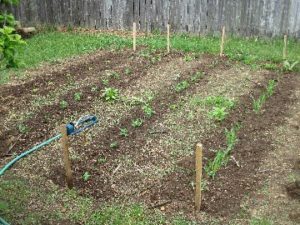
GARDENING CHORES. Planted black-eyed Susan seeds, finished lawn-mowing, weeded the garden, been watering the garden.
WATERING THE GARDEN. I use no fertilizer and no chemicals — to me, things ruining the local Pine Barrens ecosystem and time bombs in the soil and groundwater. But I water, a soaking preferably before 10 a.m., so less loss of water to evaporation in the sun’s heat and allowing the vegetation to dry so as not to pick up fungal growth. If I miss the pre-10 a.m. watering, I will try to water with a sprinkling can, low to the ground, underneath the vegetation.
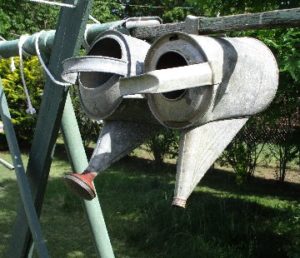
WATER CONSERVATION. Since taking over the family house in 2002, I have cut my water consumption in half for the most part. Some can be attributed to a needed bathroom remodeling (and a water-efficient toilet), but a lot is from simple conservation — do not run as much water, along with re-using gray water and rain water for watering plants. This week, for example, I watered the garden with a combination of house water and gray water, hoping to switch entirely to rain water and gray water.
MORE WATER CONSERVATION. Water from the cellar de-humidifier goes to the bird bath/watering trough. The trough, too, is recycled — a garbage can lid place on the ground, easy for birds to use, as well as squirrels and so on.
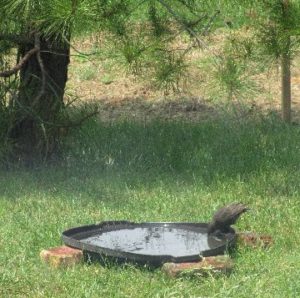
RACCOON AT THE BIRD-FEEDER. My friend continues to visit the bird-feeder, helping itself to the sunflower kernels. I let it do it for a good part of the night, then I put the feeder in the garage for the overnight.
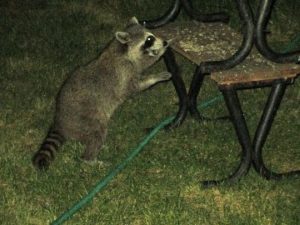
WILDLIFE AND ME. Un-rhythmic chirping crickets in my cellar in the middle of the night bring out the serial killer in me — wait till later this summer when that starts up!. But, generally, wildlife is very welcome in my yard (if not my house). This week, though, a raccoon, which I normally get within 7 or so feet of as I let it raid my bird-feeder, would not leave my garage after I startled it and it hid behind tools and so on. I poked around with a stick and finally gave up, left the doors open, and curled up on the love seat in the house until I heard rattling, meaning the raccoon was in the garbage can holding the bird seed. So, I got up, and shooed it away. Earlier, while weeding, I saw a rabbit — whose kind let me get within 5 feet or so — eating my sunflower sprouts. The hand-weeder in my hand flew across the garden. Get it? The rabbit surely understood.
WILD ON MY SIDE. Neat on the street side and neighbor side. I let my hedges and shrubs have a wild or English garden look facing inward. But I try to keep it neat on the public and neighbors’s sides. And I keep a number of wild patches in my side and back yards, making the best out of unproductive lawn ecosystems (photo 9) (I am puzzled by parents that worry about school bus stops, un-shoveled snowy sidewalks, and overcrowded classrooms, but do not worry about the chemicals on their lawns. Time bombs, I say, time bombs!)
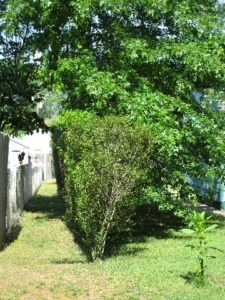
AROUND THE YARD. The season’s first bloom of Knock Out roses is wilting. Fungi (photos 11 and 12), mullein, and pokeweed sprout freely. I let this stuff grow, interested in how it looks.
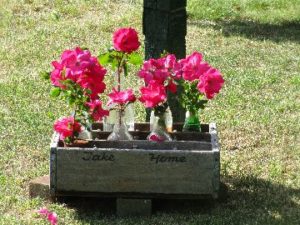
— WHAT IS GOING ON? In recent weeks, I have seen a brown thrasher (first I have seen in around 15 years), then I heard a whip-poor-will calling at my house (the first in an estimated 6 years), and, this year, the northern gray treefrogs have been hollering. Is nature coming back to the local Pine Barrens? Is the natural world becoming so condensed that nature is retreating internally? Does it mean anything?
— AND MOUNTAIN LAUREL IS BLOOMING Meaning turtles are out laying eggs, so be careful while driving. (And be careful: Do not pick them up by their tails and WATCH OUT FOR THE SNAP OF A SNAPPING TURTLE.) For the more fainthearted naturalists, the mountain laurel blooming is sort of an alarm clock that the woods will heat up, get muggy, and pine flies will be swarming.
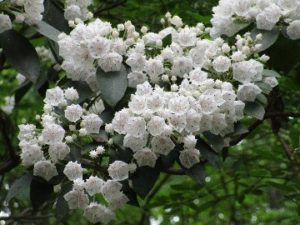
— MY INSIDE GARDEN. The view from my desk.
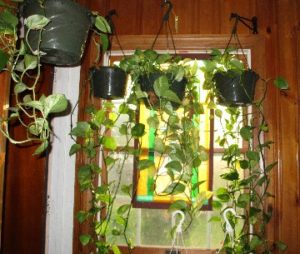
Copyright 2016 by Joseph Sapia
Joe is kicking off a new Facebook.com group, “The Jersey Midlands,” where this report is first published. To access The Jersey Midlands, go to the group and request access.
Joe Sapia, 59, is a vegetable gardener, who gardens the same backyard plot as did his Italian-American father, Joe Sr., and his Polish grandmother, Annie Poznanski Onda. Both are inspirations for his vegetable gardening. And he draws inspiration on the local Pine Barrens from his mother, Sophie Onda Sapia, who lived her whole life in the local Pines, and his grandmother.
Photos and text by Joseph Sapia
Garden and Afield in Helmetta-Monroe-Jamesburg, 2016, May 22, Sunday, to May 28, Saturday
From my yard in the Helmetta Road area of Monroe and the surrounding Pine Barrens
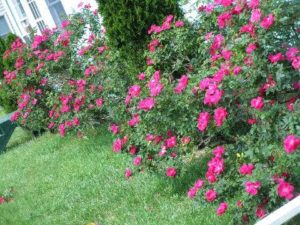
Knock-out roses
— “KNOCK OUT’ ROSES: The “Knock Out” roses are putting on a spectacular display, the best I recall since planting them in my yard in 2008.
— RACCOON/S AT THE BIRD-FEEDER: The battle continues between me and the raccoons at the bird-feeder. I have been putting the feeder in the garage at night, but the raccoon/s sometime beat me to the feeder.
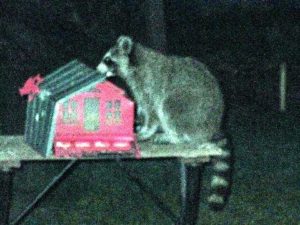
Raccoon at my backyard birdfeeder
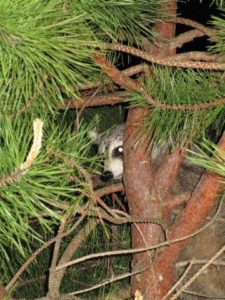
— CANADA GEESE GOSLINGS: Adult Canada geese are out and about with their goslings. The adults are amazing parents — and humans can learn from them, (Photo 6, at Helmetta Pond.)
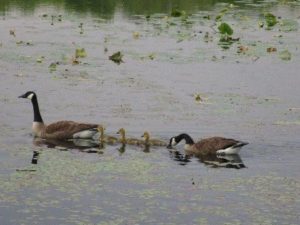
Canada Geese at Helmetta Pond
— NEW JERSEY STATE BIRD AT THE FEEDER: An Eastern goldfinch at one of my bird-feeders. Easily identified as a male because of the bright colors.
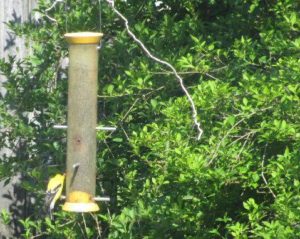
Eastern Goldfinch, the New Jersey state bird
— NORTHERN GRAY TREEFROGS: These called strongly during the week. See http://www.state.nj.us/dep/fgw/ensp/audio/no_gray_frog.wav.
— GARDEN: I planted May 21 and a week later plants were sprouting, most noticeable the Mammoth Gray-Stripe sunflower. Although I do not use fertilizer or pesticides, I water regularly. Once the plants get going, I water before 10 a.m. so as not to lose water to evaporation as the day warms.
— BLACK BEAR MOVEMENT: Reports continue about black bear sightings in Central Jersey and across the Delaware River in Pennsylvania. I am surprised there have not been more reports closer to home. If a bear is sighted, it is likely a 1-1/2-year-old male, perhaps 80 to 100 pounds, looking for its own turf. (What to do when encountering a bear, http://www.state.nj.us/dep/fgw/pdf/bear/bearfacts_know.pdf.)
— YARDWORK: I trimmed the shrubs, then started cutting the grass. I have to finish the lawncutting today. I still have to plant black-eyed Susans.
— BLAST FROM THE PAST, CIRCA LATE 1960S: Paul Migut with an 8-horsepower roto-tiller at his Uncle Stanley “Pon” Ceslowski’s garden on Old Road at Helmetta Road, Monroe. Over the years, Pon, Paul and Jim Becker worked that huge garden.

Paul Migut, circa late 1960s, at Pon’s garden
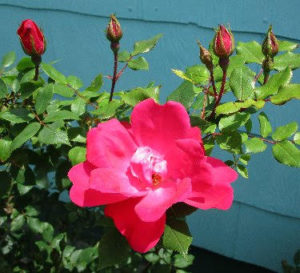
More knock-out roses
Joe Sapia, 59, is a vegetable gardener, who gardens the same backyard plot as did his Italian-American father, Joe Sr., and his Polish grandmother, Annie Poznanski Onda. Both are inspirations for his vegetable gardening. And he draws inspiration on the local Pine Barrens from his mother, Sophie Onda Sapia, who lived her whole life in the local Pines, and his grandmother.
Garden and Afield In Helmetta-Monroe-Jamesburg
2016, May 15, Sunday, to May 21, Saturday
by Joseph Sapia
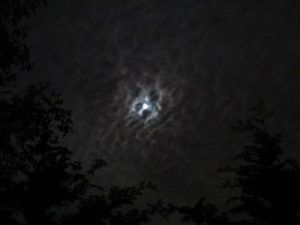
Nearly a Full Corn-Planting Moon during the week
— NIGHT SKY: On Saturday, the moon turned full, the Full Corn-Planting Moon. Look for a bright red Mars for weeks. (The photograph is of the almost-full moon over Monroe and Jamesburg.)
— VEGETABLE GARDENING: I got the vegetable garden in on Saturday, May 21, working in and out of rain. I am a bit concerned I went by the calendar, using May 20 as my guide to when the soil normally would be warm enough to plant, rather than by this year’s still-cool weather. That is, the soil may still be too cool for the warm-season vegetable plants. Perhaps I should have waited to June 1. No matter if I went with my heart over my head, the crop is in: Mammoth Gray-Stripe Sunflower, Cuppa Joe Sweet Corn, Rutgers Tomato, Hale’s Best Jumbo Cantaloupe, Born-to-be-Mild Hybrid Hot Pepper, Kaleidoscope Mix Carrot, Northern X-tra-Sweet Hybrid Sweet Corn, Igloo Lettuce, Carnival Mix Sweet Pepper, and Tasty Green Cucumber.
— OLD SEEDS: The Mammoth Gray-Stripe Sunflower, Cuppa Joe Sweet Corn, and Tasty Green Cucumber are 2015 seeds, which still should produce a crop.
— HOW I SEED: For what it is worth, I do not single-seed. Instead, I place a few to a bunch of seeds per hole.
— POLLINATION IN THE VEGETABLE GARDEN: I am trying something new in the garden, adding flowers to attract pollinators. So, I threw around seeds of Burpee’s Bee and Butterfly Garden and Monmouth Conservation Foundation’s Project Pollinator/Kids for Conservation.
— GARDENING ZONES: As the area transitions from the cooler Zone 6 to the warmer Zone 7, because of global warming, we will have a longer growing season. The gardening downside, more erratic weather. For example, many days of rain, followed by long periods of droughty weather. And, of course, the environmental downside is the global warming.
— RACCOONS AT THE BIRD-FEEDER: I enjoy watching the nightly visit of a raccoon or raccoons at the bird-feeder, sometime joined by a skunk below the feeder. I guess the raccoons and skunk like the sunflower hearts/kernels I use – and they have to eat, too, while entertaining me. But I got tired of the raccoon/s knocking down the feeder night after night. So, for now, I am bringing the feeder inside the garage at night and putting it back out in the morning.
— BIRDS: House finches were flying around the yard, fluttering to trees, bird-feeder, and clothesline, having trouble landing. They must have been fledglings, trying to figure it all out.
— WHIP-POOR-WILL CALLING: About 10:45 to 11 p.m. Wednesday night, May 18, a whip-poor-will called loudly, if only sporadically. This was once a common bird here in the local Pine Barrens – calling ad nauseam through the overnight. But this one was the first I have heard in an estimated 6 years. I got reports of whip-poor-will calls from around my Helmetta Road neighborhood, so I hoping for a return of the whip-poor-will.
— MOUNTAIN LAURELS AND SNAPPING TURTLES: Mountain laurel should begin blooming about now. So, remember this bit of Pine Barrens lore: “The snapping turtle lays its eggs, when the mountain laurel blooms.” Watch for snappers crossing roads – probably a female headed to high ground from a swamp to lay eggs or a female returning to a swamp after laying her eggs on high ground. If helping the turtle along, move it in the direction it is traveling. I MOVE A SNAPPER ONLY WITH A SHOVEL, because here is more Piney lore to think about, “Only the setting sun or lightning makes the snapping turtle let go.” If bitten, try running a wire down its nostril to make it let go. (Moving a snapper by lifting it by its tail could hurt it – and, also, it could bite the mover and not let go….)
(Garden observations are from my yard in the Helmetta Road area. Pine Barrens observations are from the Helmetta-Monroe area Pines.)
Joe Sapia, 59, is a vegetable gardener, who gardens the same backyard plot as did his Italian-American father, Joe Sr., and his Polish grandmother, Annie Poznanski Onda. Both are inspirations for his vegetable gardening. And he draws inspiration on the local Pine Barrens from his mother, Sophie Onda Sapia, who lived her whole life in the local Pines, and his grandmother.
Article and photos by Joe Mish

This female red phase screech owl with erect ear tufts and large eyes looks as ferocious as it sometimes sounds.
The calm starlit night, made blacker by the dark phase of the moon, was the perfect setting for a peaceful night’s sleep. The windows were wide open and the air scented with honeysuckle as the gentle sounds of the night played a sleepy time lullaby.
Deep sleep and dreams were well under way when a primal scream, just outside the window, vibrated the walls. Everyone sat up, hearts beating wildly, sleeping coonhounds unleashing unheard of sounds that must have been reserved in the event they ever treed the devil.
Before my heart beat slowed, I figured the sounds had to come from a screech owl perched on a tree limb six feet from the bedroom window. The unearthly screams were one selection of screech owl vocalizations that include rapid clicking of its beak and a gentle wavering call that, through association with spooky movies can easily raise the hairs on the back of your neck.
The volume of a screech owls’ motivated scream is inconsistent with its small size. The eastern screech owl is about 9 inches tall, weighs around 6 ounces with a 24 inch wingspan and easily fits through a three inch nest box hole.
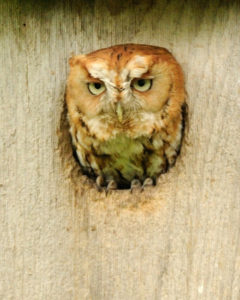
Adult red phase screech owl perches in 3″ hole of its nest box, note the feet gripping the edge of the opening.
Eastern screech owls come in two colors, a red phase and a gray phase. Its physical appearance, while perched, gives the impression it is missing the lower half of its body. During the day with its eyes shut it blends in so perfectly with its background it is difficult to tell what part is what. The owl seems to suddenly appear from the background when it opens its large yellow eyes.
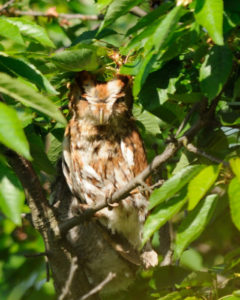
Eyes closed, these owls seems to disappear with no reference to top or bottom or recognizable form.
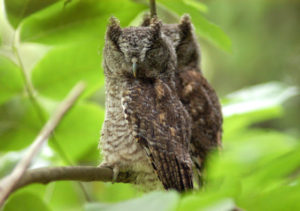
Screech owls seem to comfortably tolerate humans and can be seen, and will nest, in proximity to homes and buildings if a nest box is provided.
Late June early July, a screech owl would show up whenever I went into the backyard around dusk. It would follow me around and click its beak from a nearby branch. I have no idea what motivated that behavior but that owl provide plenty of photo opportunities.
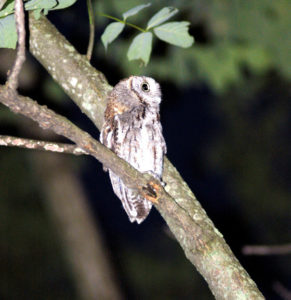
Then there were the memorable Christmas day visits. One Christmas morning I went to the open woodshed to replenish the woodstove with an armful of oak. There, staring me in the face from four feet away was a gray phase screech owl. It stayed put while I gathered the wood but was gone when I returned with my camera.
A few years later on Christmas night, a red phase screech owl perched a few feet off the ground in a weeping cherry tree. The little owl was spotted by the car’s headlights. It remained undisturbed while I did capture its image.
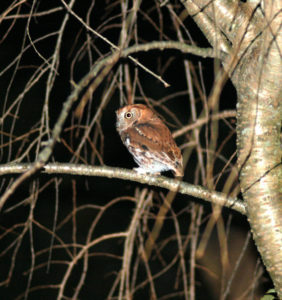
A late Christmas present in full feather, delivered at the front door.
Screech owls may just as well be found in deep woods. I have a great image of a red phase owl sitting in a healed hole in the side of a large tree trunk about eight feet off the ground. Other sightings have been in places where mature sycamore trees grow. Often, broken branches will leave a cavity that overtime becomes deeper, forming a perfect nest or day time resting place for this diminutive owl.
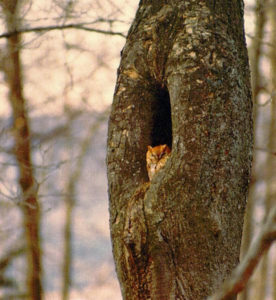
Though screech owls are quite common, you may never see one. Think of them as a night time radio host whose show you listen to all the time but never put a face to the voice. Hear a sampling of screech owl calls at: https://www.allaboutbirds.org/guide/Eastern_Screech-Owl/sounds
Author Joe Mish has been running wild in New Jersey since childhood when he found ways to escape his mother’s watchful eyes. He continues to trek the swamps, rivers and thickets seeking to share, with the residents and visitors, all of the state’s natural beauty hidden within full view. To read more of his writing and view more of his gorgeous photographs visit Winter Bear Rising, his wordpress blog. Joe’s series “Nature on the Raritan, Hidden in Plain View” runs monthly as part of the LRWP “Voices of the Watershed” series. Writing and photos used with permission from the author.
Our friend and “Voices of the Watershed: Pinelands of Helmetta” contributor Joe Sapia writes:
“Wow, I just heard a whip-poor-will calling at my house in the Helmetta Road area. That is the first time in about 6 years I have heard this bird, once a harbinger of spring in the local Pine Barrens, since about 2010.
Antrostomus vociferus is considered a jeopardized species in NJ. This one, I heard from about 10:45 p.m. to 11 p.m. Its call was powerful, meaning it was close, but it was sporadic, not the ad nauseam call.
Listen to an example and multiply that all night.
Around here, I would say this bird is a Pine Barrens bird, so it could be heard in parts of Monroe (north of Jamesburg and hugging the Old Bridge and Manalapan boundaries), anywhere in Helmetta and Spotswood, and other local Pine Barrens areas.
If you hear one locally, let me know when and the general location. Thanks.
A few weeks ago, I saw a brown thrasher, “Toxostoma rufum,” the first one I saw locally in years. What is going on?”
Article and photos by Joe Mish
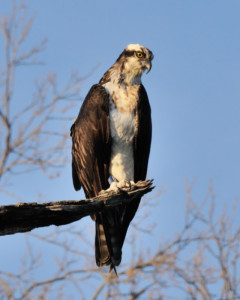
The osprey from Maine searches the clear water of the South Branch for a meal as she takes a break from her 2,500 mile journey north. The letters, DV, can be seen on the blue band attached to her right leg.
The warmth from the mid-morning sun felt good on my back as I paddled the low, clear water of the South Branch. The cloudless sky, directly above, was a darker shade of blue, its intensity pure and endless, and mesmerizing. It compelled me, as the devil’s advocate, to search for just a single speck to interrupt its perfection.
Suddenly a shadow sped across the water, momentarily stealing the sunlight. I instinctively looked up to catch a glimpse of an osprey circling above. The white head, streaked with a dark brown stripe, was instantly recognizable. The osprey proceeded downriver by making tight overlapping circles in its search for fish. It isn’t too hard to imagine some of these super intelligent predators realize a canoe is herding the fish ahead of it. When the osprey was about 150 yards downstream it tucked its wings and dove into foot deep water to come up with a large white sucker held fast in its black talons. The bird oriented the position of the fish to cut wind resistance as it flew out of sight.
Ospreys are ever present on the South Branch, typically from early spring to mid autumn. They feed primarily on live fish. I see them most often eating white suckers, a fish large enough to compensate for the energy spent to catch it.
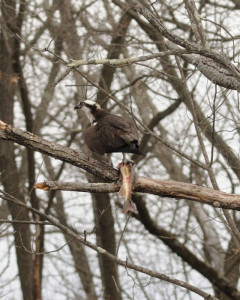
Osprey on a riverside perch, dining on fresh fish during the 2014 NJ opening day of trout season.
Earlier this April, I noticed an osprey perched in the same location day after day. This wasn’t typical of the local ospreys that ranged far and wide in their constant search for food. I was able to get a few photos and noticed a blue band on the right leg and a silver band on the left. I reported the band to the USGS website, BandReports@usgs.gov, to find this osprey was banded in Portland, Maine, July 27th, 2011 while it was still in the nest, too young to fly.
Osprey migrate from the northeast, where they breed, to central and South America each fall, a trip of more than 2,500 miles. This bird was apparently on its way back to Maine and stopped to rest. Osprey, like other migratory birds, are very loyal to nest sites and return to the same location with great predictability.
Consider our visiting osprey will be 5 years old this July, and has 25,000 plus, frequent flyer miles on its account, you have to recoil in amazement, wonder and respect for its strength and tenacity. As osprey can live 25 to 30 years or more, the mileage really adds up.
Our Maine visitor, a female, as evidenced by her speckled décolletage, has a bright and long future and hopefully will stop along the South Branch again on her journey to and from Central America. No doubt other osprey are flying to northern breeding grounds through NJ, so the opportunity to spot a banded bird along the North and South Branch are quite good.
The reporting of banded birds is critical to wildlife research as it helps to unravel the mystery of migration, the location of breeding grounds, longevity, and other variables that impact the health and status of local and overall wildlife populations.
New Jersey is now using red bands for osprey and from Ben Wurst at conservewildlifenj.org, as per USGS; “Green anodized bands are being used in NY. Purple anodized bands in MD and VA. Red anodized bands (like ours, but with alpha code A&B 00-99) in PA (permit is expired now). Blue anodized bands in MA, ME & Ontario.”
The preponderance of osprey nests in NJ are along the Delaware River and Atlantic shoreline, its estuaries, bays and rivers, so keep an eye out for banded birds and report them to BandReports@usgs.gov . The researchers are as excited about a band report as you and will send a certificate of appreciation with relevant data about your bird. Many species of birds are banded, so don’t forget our eagles, hawks and songbirds. Opportunities abound as NJ is on a major flyway, the rivers being main exit and entrance ramps to our backyard.
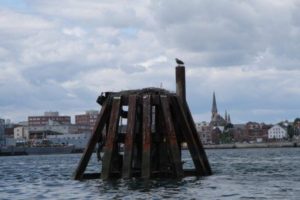
*Joe sent us an update to this post, a photo of the exact location in Maine where the osprey was born. Photo courtesy of Lauren Gilpatrick at the Biodiversity Research Institute, Portland Maine.
See, http://www.conservewildlifenj.org/education/ospreycam/ for more details about NJ osprey project and live osprey cam.
Special thanks to Robert Somes, Kathy Clark and Ben Wurst for their enthusiastic help and support.
Robert Somes, Senior Zoologist
NJ Division of Fish and Wildlife
Endangered and Nongame Species Program
Kathy Clark,CWB,
NJ Division of Fish and Wildlife
Endangered and Nongame Species Program,
Ben Wurst, Habitat Program Manager
New Jersey Osprey Project
Author Joe Mish has been running wild in New Jersey since childhood when he found ways to escape his mother’s watchful eyes. He continues to trek the swamps, rivers and thickets seeking to share, with the residents and visitors, all of the state’s natural beauty hidden within full view. To read more of his writing and view more of his gorgeous photographs visit Winter Bear Rising, his wordpress blog. Joe’s series “Nature on the Raritan, Hidden in Plain View” runs monthly as part of the LRWP “Voices of the Watershed” series. Writing and photos used with permission from the author.
By: Heather Fenyk
Part of the fun of reading comic books when I was a kid was coming across ads for the absurd: Monster Size Monsters! X-Ray Vision Glasses! Kung-fu Sandals! (AUTHENTIC! Worn for Centuries by Oriental Fighting Masters!) But my absolute favorite adverts included invitations to “Own A Bowl Full of Happiness.” For just 49¢ plus $2.99 shipping, you could raise your own “trainable” insta-pet, the Sea Monkey.
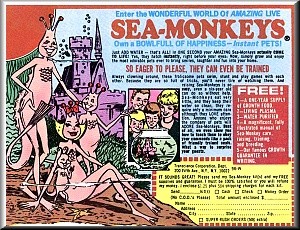
Sea-Monkey ad from 1970’s comic book
Sea Monkeys fall into a general group of organisms including brine shrimp and “fairy shrimp” that, with the proper mix of nutrients and chemicals, can be stored in dry form and then “revived” with a dose of plain tap water.
Recent rains have nourished our New Jersey swamps and freshwater marshes, transforming seeming terra firma into vernal or ephemeral ponds. These ponds – or more specifically their “fairy shrimp” inhabitants – get me out in the field looking for Sea Monkeys.
The descriptive terms for these freshwater wetland types — “vernal” and “ephemeral” — refers to their habit of appearing in spring and being short-lived or temporary. Many vernal ponds in New Jersey and elsewhere were not protected during the post-World War II building boom. But with the passage of the New Jersey Freshwater Wetlands Protection Action in 1987, all freshwater wetlands – including these temporary wetlands – were finally granted protection. Fairy shrimp benefit directly from these protection measures.
A common species of fairy shrimp in our New Jersey vernal ponds is Eubranchipus vernalis. It grows between 0.5 and 1.5 inches in length, and other than its forked tail and large, stalked, compound eyes, its most obvious features are the 11 pairs of feathery appendages it uses for swimming, breathing and feeding. It collects algae, bacteria, protozoa, rotifers, and detritus on the feather-like structures and transfers that material to its mouth by other appendages. In addition, it will scavenge dead tadpoles, mollusks and amphibian eggs.
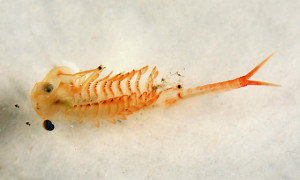
Eubranchipus vernalis. Image from www.bugguide.net
The shrimp’s reproductive strategy is fascinating. After mating, the male dies. The females are easily distinguished from males by the egg-filled brood sac on their abdomen, and the sac contains one of two types of fertilized eggs depending on the density of males in the pond. A low density of males results in thin-shelled “summer eggs,” which have a very short incubation period and hatch inside the brood sac. A high density of males results in thick-shelled “winter eggs” that eventually fall to the bottom of the pond and remain there even when the pond dries out. They will hatch the following spring, when the pond refills, and they have an amazing capacity to withstand extreme elements, including temperatures that are probably never encountered in nature: from a high of just below boiling (210 degrees) to a low extreme of -310 degrees.
The powdered thick-walled eggs of fairy shrimp are the type that my sister Julie purchased in 1978 from the back of an Archie Comic Book. It is this egg stage that enables the fairy shrimp to be distributed to other potential vernal ponds. Fairy shrimp eggs are tiny, dry granules that can be blown by the wind or picked up on the feet of animals and carried to other vernal ponds. These thick-walled, dry eggs remain viable even after 15 years, and the eggs are supposed to hatch 30 hours after being submerged in water.
Sadly, Julie’s order of Sea Monkeys never hatched. While she was perhaps permanently scarred by being duped into purchasing a package of powdered brine shrimp, I remain suckered in by the advertising and happily spend spring weekends exploring New Jersey’s vernal pools looking for my own Sea Monkeys to train.
Happy National Sea Monkey Day!
Article and photos by Joe Mish
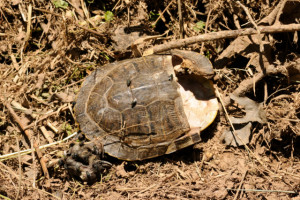
A slow journey that began more than a million years before, ended at the tip of a mower blade spinning at 3,200 rpm. This wood turtle, listed as ‘threatened’ in New Jersey, was killed in late May, while on its way to lay eggs.
May and June have been the peak of the great turtle migration where females, laden with eggs, leave the protection of quiet places to journey far and wide to dig holes and bury their eggs. Incubation takes about 70 days, more or less, and nests are left unattended.
All species, whether aquatic, terrestrial or both, like the wood turtle, seek dry land to lay eggs. Each has a preference for where and when they dig nests, though individual variation is the rule.
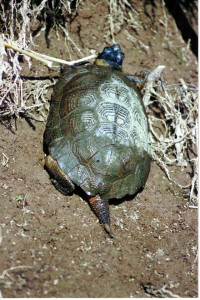
A wood turtle on its way out of the river where it hibernated to lay eggs in the gravel soil near railroad tracks.
Wood turtles prefer gravel laden soil on high ground, as found along railroad tracks, roadsides and driveways.
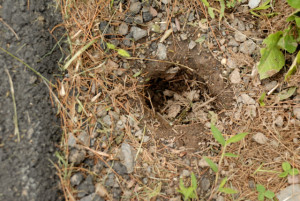
Roadways have become the killing fields for these slow moving reptiles where large blocks of undisturbed habitat are segmented by roads. A preserved island of land may be celebrated as a conservation success but the lack of linear greenways to bridge these islands is a death knell for many small creatures as it exposes them to predation and roadkill.
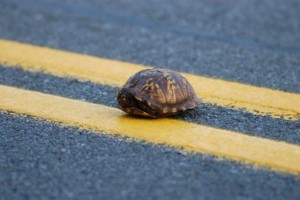
Eastern box turtle pauses mid journey across a New Jersey roadway, in a false retreat that offers no protection form speeding vehicles.
Turtles are creatures of habit and maintain consistent pathways from year to year. So that eastern box turtle you saw crossing over the double yellow line last year will be crossing the road in the same place this nesting season.
Mowing tall grass during nesting season is a more insidious cause of death for turtles and grassland nesting birds. Many farmers and landowners alter their mowing schedule to prevent killing fawns and game birds; turtles and grassland nesting birds are coincidental beneficiaries.
State conservation organizations advocate mowing early in the season and then not again until August, late July at the earliest.
A driver may possibly avoid killing a turtle on a paved road as it is somewhat visible, while a turtle in tall grass is a foregone conclusion when a mower runs through a field. The fractured shell of the wood turtle pictured, was found on a path mowed through an overgrown pasture near the South Branch.
Females may travel half a mile from wet areas to lay eggs, so please be careful. As the wood turtle is considered, “threatened “, and known to populate our area, special caution should be taken. May 29, 2015, a female wood turtle was observed digging a nest within inches of a long paved private drive, in hard packed gravel. This would be the last place you’d ever expect a turtle to dig, as you would be hard pressed with a pick and shovel to penetrate that ground. The hole was about 5 inches deep and 4 inches wide.
An awareness of turtles and their nest sites are a prerequisite to protecting them. As the eggs are laid in a small hole, covered and left unattended, you’d never know you were endangering a nest. Many eggs don’t hatch or are destroyed by predators. Then imagine an inch long hatchling trying to traverse a quarter mile through fields and open ground in an effort to reach water, bog or swamp. Survivors are few and far between.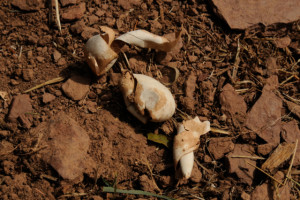
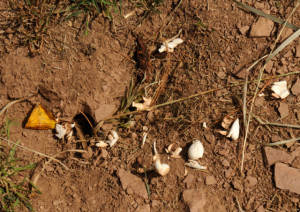
…you will find collapsed leathery egg shells scattered about; though they won’t look like egg shells. Imagine an egg shell make of cloth and inwardly collapsed to appear as a scrap of white material.
With poor odds for survival, it begs at least awareness on our part to, “first, do no harm”, and avoid destroying nests or mulching hatchlings and adults with a mower.
Turtles remain in their essential form that traces back to prehistoric times. Their evolution is an unrivaled success, even more astounding when their slow lumbering movements and low reproduction rate are considered.
Some interesting anatomical features reveal the secrets hidden behind the shell. See how the spinal cord is integral to the carapace or top shell in this painted turtle. The box turtle shell shows the spine as well as the clavicle. The thin plates that line the outer surface of the shell are attached much like a fingernail.
The easiest way to find a turtle nest is to look for the open holes in late summer and early fall. Either the nests were naturally opened by emerging turtlettes or dug out by raiding predators. In either case you will find collapsed leathery egg shells scattered about; though they won’t look like egg shells. Imagine an egg shell make of cloth and inwardly collapsed to appear as a scrap of white material. Last year I found 6 nests, one, just outside my back door. I had never seen a nest before but once I knew what to look for, they seemed to be everywhere.
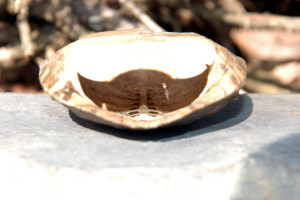
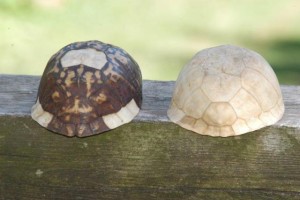
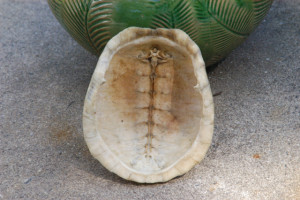
The Unami, one of the three matrilineal clans of the Lenape indians, who lived in central New Jersey, were known as the Turtle Clan. Treating the turtle with respect, keeps the clan of the turtle alive and well in the land it has known since the last glaciers receded and the land emerged from the sea. Consider, the turtle had arrived at it final evolutionary form long before humans. As new to the neighborhood, we might look to the turtle for guidance as we would a centenarian, to seek advice on how to live a long life in alignment and peace with our ever changing environment.
Author Joe Mish has been running wild in New Jersey since childhood when he found ways to escape his mother’s watchful eyes. He continues to trek the swamps, rivers and thickets seeking to share, with the residents and visitors, all of the state’s natural beauty hidden within full view. To read more of his writing and view more of his gorgeous photographs visit Winter Bear Rising, hiswordpress blog. Writing and photos used with permission from the author.
by Maya Fenyk (age 11), LRWP youth consultant and “Endangered & Threatened Species” series contributor
Hello! I am Myosis Sodalis, but you can call me Clementine the Indiana Bat. I am an endangered species, which means that I am likely to become extinct. Because of my endangered status, my habitat is considered “critical.” This means that special efforts are supposed to be taken to protect the important characteristics of where I live. I live in caves and roosts throughout the central part of the United States and the East Coast, including parts of New Jersey and the Lower Raritan Watershed.
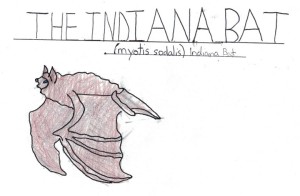
Clementine, the Indiana Bat (drawing by Maya Fenyk)
Some people are scared of me (and of bats in general), but they shouldn’t be. Bats do a lot of work for humans! We are great at pest control, pollination and spreading seeds. Farmers especially appreciate what we do. And if you think about how many pesky mosquitos we eat every night you will start to appreciate us, too! Even though we help out in so many ways there are a lot of issues that make it hard for me and my friends to survive and to do our important jobs. There are lots of threats to our survival – like development near caves and old mines (the places that we stay during hibernation), deforestation of our summer roosts, the use of pesticides, and White Nose Syndrome (WNS). WNS is really scary – it is a fungus that grows on our bodies that leads to starvation and to our freezing to death. Did you know that there are things that YOU can do to help protect me and my habitat? There are things you can do that will make it so that my friends and I can survive and continue to do the pest removal and farming work that helps you humans out!
Before I tell you how you can help out, you should first know a few things about me, like where I live and what I look like. I’m a relatively small bat, only 3.5 inches long. But I have a ginormous wingspan of 10.5 inches! I have black eyes, big ears, a pink nose and very short toe hairs. I also have very strong ridged calcar (the cartilage between my wing joints). I really like to find secret and protected areas to stay with the rest of my maternity colony during the winter months. The maternity colonies – in abandoned mines or caves – are wonderful happy places. I have a lot of friends there. I’m a mommy bat, and the other mommy bats and I work together to keep our babies safe and fed. Unfortunately, over the years a lot of development near caves and old mines has made it really hard for me and my friends to meet together in the large mines or caves that allow us to share the protections of maternity colonies. This means that I often have to find isolated caves to live in, and when I go out to hunt food I have to leave my babies alone without my friends to help me watch over them. As a result my babies end up as easy prey for predators including snakes, owls and raccoons. Development has also affected our summer habitat.
When my kids become juveniles they need time outside of the cave to mature and to learn to hunt bugs and to live on their own. But deforestation and removal of our trees has led to fewer and fewer places for us to safely spend our summers. I do have one favorite summer home on the banks of the Raritan River in New Brunswick – I know that there are protections in place there that keep municipal maintenance crews out of my home during the crucial summer months. Thanks to attention to state laws no one comes in to bother me and my kids!
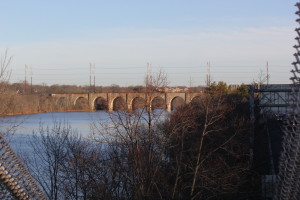
Indiana Bat Habitat in New Brunswick, NJ (image: Heather Fenyk)
Even though we might not have humans coming directly into our summer homes we still have to deal with poisoned food. That’s right – the White Nose Syndrome I told you about is most directly linked to eating bugs that are sick from pesticides that you humans put on your fields and lawns. WNS creates a fungus that makes my hair fall out, and that covers my nose and makes it hard to eat. And when my hair falls out I might freeze during the winter! Other ways that WNS is spread is by coming into contact with gear that humans carry from cave to cave when they explore our homes.
There are things that you can do to help protect me. These include protecting my habitat, including my winter and summer roosts. My summer roost is in the inside of a dead oak so it is very important that you don’t cut down dead trees unless they are diseased. Not only could that decomposing tree in your backyard be MY home, it is also important to the health of the soil to have the decomposing plant matter enrich the soil. And keep my summer roost clean! But only clean-up during winter months (November through March) so you don’t disturb me while I’m roosting. Please respect my winter roost, too. My pups are experiencing their first hibernacula in our winter roost – a cave. My pups are trying to conserve energy for when it becomes warmer and are very vulnerable if I have to go out to hunt for bugs to feed them. You should know not to come into my cave, and if you do at least clean your gear before you do because WNS can be spread from cave to cave on the gear of humans.
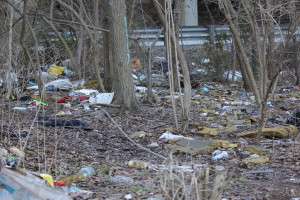
Please clean up my habitat! (Image: Heather Fenyk)
Other ways you can help save my species is to stop using pesticides in your garden, stop cutting down trees and leave the wild as it should be. It’s great to meet you – please look for me at twilight when I’m out hunting bugs. The Lower Raritan Watershed is an especially good place to find me during the summers – it is the middle ground for my long range from Michigan to North Carolina. And if you see me or any of my friends please contact the Lower Raritan Watershed Partnership to let them know. They are working to document Indiana Bat sightings to help to protect our habitat. Now please excuse me. I must go prepare to move for it is the time of year where we are readying our juveniles to head to our summer roost. Clementine the Indiana Bat signing off!










































